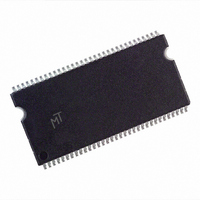MT46V32M4TG-6T:D TR Micron Technology Inc, MT46V32M4TG-6T:D TR Datasheet - Page 15

MT46V32M4TG-6T:D TR
Manufacturer Part Number
MT46V32M4TG-6T:D TR
Description
IC DDR SDRAM 128MBIT 6NS 66TSOP
Manufacturer
Micron Technology Inc
Datasheet
1.MT46V32M4TG-6TD_TR.pdf
(93 pages)
Specifications of MT46V32M4TG-6T:D TR
Format - Memory
RAM
Memory Type
DDR SDRAM
Memory Size
128M (32Mx4)
Speed
6ns
Interface
Parallel
Voltage - Supply
2.3 V ~ 2.7 V
Operating Temperature
0°C ~ 70°C
Package / Case
66-TSOP
Lead Free Status / RoHS Status
Contains lead / RoHS non-compliant
Other names
557-1024-2
Register Definition
Mode Register
Burst Length
Burst Type
09005aef8074a655
128MBDDRx4x8x16_2.fm - Rev. J 4/05 EN
The mode register is used to define the specific mode of operation of the DDR SDRAM.
This definition includes the selection of a burst length, a burst type, a CAS latency and
an operating mode, as shown in Figure 7 on page 16. The mode register is programmed
via the MODE REGISTER SET command (with BA0 = 0 and BA1 = 0) and will retain the
stored information until it is programmed again or the device loses power (except for bit
A8, which is self-clearing).
Reprogramming the mode register will not alter the contents of the memory, provided it
is performed correctly. The mode register must be loaded (reloaded) when all banks are
idle and no bursts are in progress, and the controller must wait the specified time before
initiating the subsequent operation. Violating either of these requirements will result in
unspecified operation.
Mode register bits A0-A2 specify the burst length, A3 specifies the type of burst (sequen-
tial or interleaved), A4-A6 specify the CAS latency, and A7-A11 specify the operating
mode.
Read and write accesses to the DDR SDRAM are burst oriented, with the burst length
being programmable, as shown in Figure 7. The burst length determines the maximum
number of column locations that can be accessed for a given READ or WRITE command.
Burst lengths of 2, 4, or 8 locations are available for both the sequential and the inter-
leaved burst types.
Reserved states should not be used, as unknown operation or incompatibility with
future versions may result.
When a READ or WRITE command is issued, a block of columns equal to the burst
length is effectively selected. All accesses for that burst take place within this block,
meaning that the burst will wrap within the block if a boundary is reached. The block is
uniquely selected by A1-Ai when the burst length is set to two, by A2-Ai when the burst
length is set to four and by A3-Ai when the burst length is set to eight (where Ai is the
most significant column address bit for a given configuration). The remaining (least sig-
nificant) address bit(s) is (are) used to select the starting location within the block. The
programmed burst length applies to both READ and WRITE bursts.
Accesses within a given burst may be programmed to be either sequential or interleaved;
this is referred to as the burst type and is selected via bit M3.
The ordering of accesses within a burst is determined by the burst length, the burst type
and the starting column address, as shown in Table 6, Burst Definition, on page 17.
15
Micron Technology, Inc., reserves the right to change products or specifications without notice.
128Mb: x4, x8, x16 DDR SDRAM
©2000 Micron Technology, Inc. All rights reserved.
Register Definition















